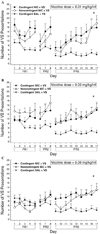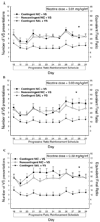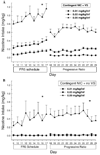Self-administered and noncontingent nicotine enhance reinforced operant responding in rats: impact of nicotine dose and reinforcement schedule
- PMID: 16847680
- PMCID: PMC2838240
- DOI: 10.1007/s00213-006-0454-8
Self-administered and noncontingent nicotine enhance reinforced operant responding in rats: impact of nicotine dose and reinforcement schedule
Abstract
Rationale: Nicotine infusions that are self-administered (contingent) or response-independent (noncontingent) increase lever pressing for a reinforcing nonpharmacological stimulus in rats, suggesting that in addition to primary reinforcement, nicotine self-administration may result from nicotine enhancing the reinforcement derived from nonnicotine stimuli.
Objectives: Based on our previous research, in this study, we tested the hypothesis that contingent and noncontingent nicotine would equally elevate responding for a moderately reinforcing visual stimulus, across a range of nicotine doses on both fixed ratio and progressive ratio reinforcement schedules.
Materials and methods: The rats lever pressed for a visual stimulus with contingent nicotine, noncontingent nicotine, or contingent saline. Separate groups responded for saline or nicotine without the visual stimulus. Three doses of nicotine (0.01, 0.03, and 0.09 mg/kg per infusion, free base) were tested in a between-groups design. After responding on an escalating fixed ratio reinforcement schedule, the rats were tested on a progressive ratio schedule.
Results: Compared to responding for the visual stimulus with saline, both contingent and noncontingent nicotine equally elevated lever pressing for the stimulus at each dose on fixed and progressive ratio schedules. In the absence of the stimulus, only the highest nicotine dose sustained self-administration.
Conclusions: The ability of noncontingent nicotine to elevate responding for a moderately reinforcing visual stimulus occurs across a range of doses, and both self-administered and noncontingent nicotine equally increase motivation to obtain the stimulus, as reflected by performance on a progressive ratio schedule. In the absence of a contingent stimulus, primary reinforcement from nicotine only supports self-administration at high nicotine doses in rats.
Figures




Similar articles
-
Operant responding for conditioned and unconditioned reinforcers in rats is differentially enhanced by the primary reinforcing and reinforcement-enhancing effects of nicotine.Psychopharmacology (Berl). 2006 Nov;189(1):27-36. doi: 10.1007/s00213-006-0522-0. Epub 2006 Sep 22. Psychopharmacology (Berl). 2006. PMID: 17019569
-
Operant responding for a visual reinforcer in rats is enhanced by noncontingent nicotine: implications for nicotine self-administration and reinforcement.Psychopharmacology (Berl). 2003 Aug;169(1):68-76. doi: 10.1007/s00213-003-1473-3. Epub 2003 May 28. Psychopharmacology (Berl). 2003. PMID: 12774186
-
Conditioned reinforcement in rats established with self-administered nicotine and enhanced by noncontingent nicotine.Psychopharmacology (Berl). 2007 Dec;195(2):235-43. doi: 10.1007/s00213-007-0897-6. Epub 2007 Aug 5. Psychopharmacology (Berl). 2007. PMID: 17676401 Free PMC article.
-
Complex interactions between nicotine and nonpharmacological stimuli reveal multiple roles for nicotine in reinforcement.Psychopharmacology (Berl). 2006 Mar;184(3-4):353-66. doi: 10.1007/s00213-005-0178-1. Epub 2005 Oct 21. Psychopharmacology (Berl). 2006. PMID: 16240165 Review.
-
Second-order schedules of drug reinforcement in rats and monkeys: measurement of reinforcing efficacy and drug-seeking behaviour.Psychopharmacology (Berl). 2000 Dec;153(1):17-30. doi: 10.1007/s002130000566. Psychopharmacology (Berl). 2000. PMID: 11255926 Review.
Cited by
-
Behavioral effects of phencyclidine on nicotine self-administration and reinstatement in the presence or absence of a visual stimulus in rats.Psychopharmacology (Berl). 2015 Aug;232(16):2877-87. doi: 10.1007/s00213-015-3923-0. Epub 2015 Apr 7. Psychopharmacology (Berl). 2015. PMID: 25845436 Free PMC article.
-
Nicotine Enhances Footshock- and Lithium Chloride-Conditioned Place Avoidance in Male Rats.Nicotine Tob Res. 2016 Sep;18(9):1920-3. doi: 10.1093/ntr/ntw098. Epub 2016 May 13. Nicotine Tob Res. 2016. PMID: 27178831 Free PMC article.
-
Facilitation of intravenous nicotine self-administration in rats by a motivationally neutral sensory stimulus.Psychopharmacology (Berl). 2009 Dec;207(2):191-200. doi: 10.1007/s00213-009-1647-8. Epub 2009 Sep 16. Psychopharmacology (Berl). 2009. PMID: 19756529
-
The generality of nicotine as a reinforcer enhancer in rats: effects on responding maintained by primary and conditioned reinforcers and resistance to extinction.Psychopharmacology (Berl). 2008 Dec;201(2):305-14. doi: 10.1007/s00213-008-1282-9. Epub 2008 Aug 10. Psychopharmacology (Berl). 2008. PMID: 18695928
-
Reinforcement enhancement by nicotine in adult rats: behavioral selectivity and relation to mode of delivery and blood nicotine levels.Psychopharmacology (Berl). 2018 Mar;235(3):641-650. doi: 10.1007/s00213-017-4778-3. Epub 2017 Nov 11. Psychopharmacology (Berl). 2018. PMID: 29128873
References
-
- Addy NA, Nakijama A, Levin ED. Nicotinic mechanisms of memory: effects of acute local DHbetaE and MLA infusions in the basolateral amygdala. Brain Res Cogn Brain Res. 2003;16:51–57. - PubMed
-
- Barr AM, Phillips AG. Withdrawal following repeated exposure to d-amphetamine decreases responding for a sucrose solution as measured by a progressive ratio schedule of reinforcement. Psychopharmacology (Berl) 1999;141:99–106. - PubMed
-
- Caggiula AR, Donny EC, White AR, Chaudhri N, Booth S, Gharib MA, Hoffman A, Perkins KA, Sved AF. Environmental stimuli promote the acquisition of nicotine self-administration in rats. Psychopharmacology (Berl) 2002a;163:230–237. - PubMed
-
- Caggiula AR, Donny EC, Chaudhri N, Perkins KA, Evans-Martin FF, Sved AF. Importance of nonpharmacological factors in nicotine self-administration. Physiol Behav. 2002b;77:683–687. - PubMed
-
- Chaudhri N. Complex interactions between nicotine and nonpharmacological stimuli reveal a novel role for nicotine in reinforcement. Pittsburgh, PA: Department of Neuroscience, University of Pittsburgh; 2005. - PubMed
Publication types
MeSH terms
Substances
Grants and funding
LinkOut - more resources
Full Text Sources

